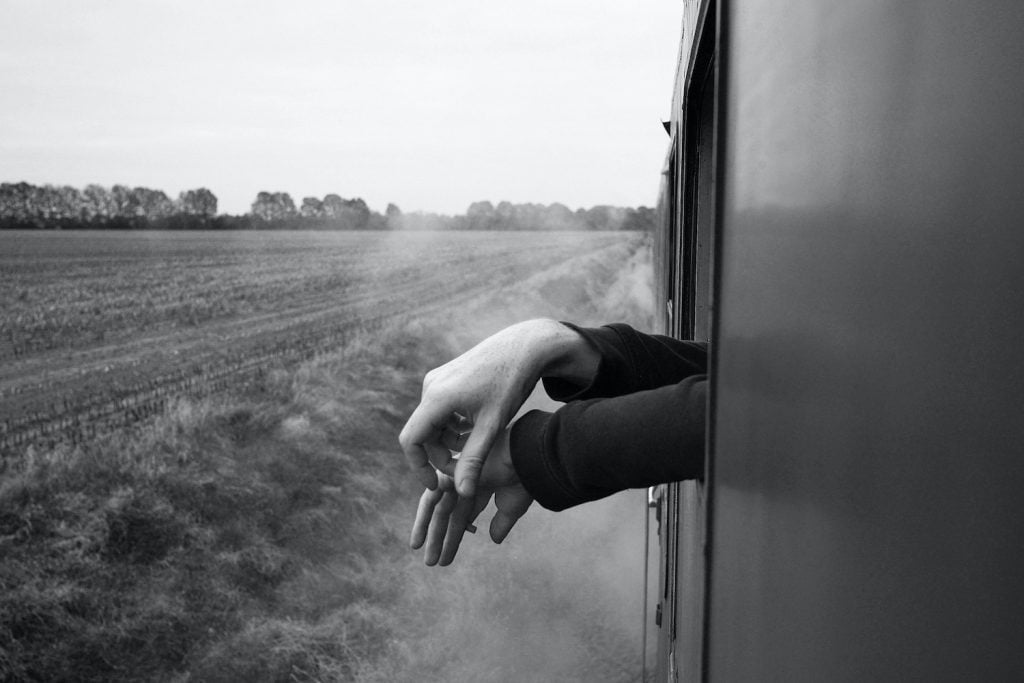Shortly before Roger Deakins sat down for this interview about his new book of photographs, Byways, the cinematographer received an email from director Denis Villeneuve.
“I can see it’s you,” Deakins recalled Villeneuve saying about the book, meaning that the director recognized the eye behind the images.
I can too. Embedded throughout Byways, published this month by Damiani, are many of the Deakins hallmarks made famous by his lens work for directors like Sam Mendes and the Coen brothers, and in such acclaimed films as The Shawshank Redemption and Blade Runner 2049. (The latter is one of three films he’s made with Villeneuve.). In the book, the yawning highways and wind-whipped hills from a set of shots taken outside Albuquerque seem to recall the landscapes of No Country for Old Men, for instance, while a handful of bleached-out Norwegian vistas put Fargo front of mind. Occasionally, the connections are more overt: here, the tree from the parting shot of Mendes’s 1917 makes a more permanent cameo on the page.
As a cinematographer, Deakins looms large: he is, for many movie peoples’ money, the greatest person doing the job today (witness his 15 Oscar nominations, and two wins). But his reputation as a fine-art photographer is far less developed. Not only is Byways his first monograph, it’s also the first place many of these pictures have ever been shared publicly.
It’s for this reason that, as satisfying as the similarities between his films and these pictures are, the differences are just as revealing. Comparing the two bodies of work is an exercise in comparing the essences of film and photography, and an uncommon opportunity at that: rare are the practitioners who are equally accomplished in both formats.
The central difference between Deakins’s two bodies of work makes spending time with Byways a special pleasure. Whereas a film is a collaborative endeavor, one routed through the mind of its director, this collection of still images represents a wholly personal project. It may be the purest distillation of Deakins’s vision—stark, plaintive, reverent of land and light—we ever get.
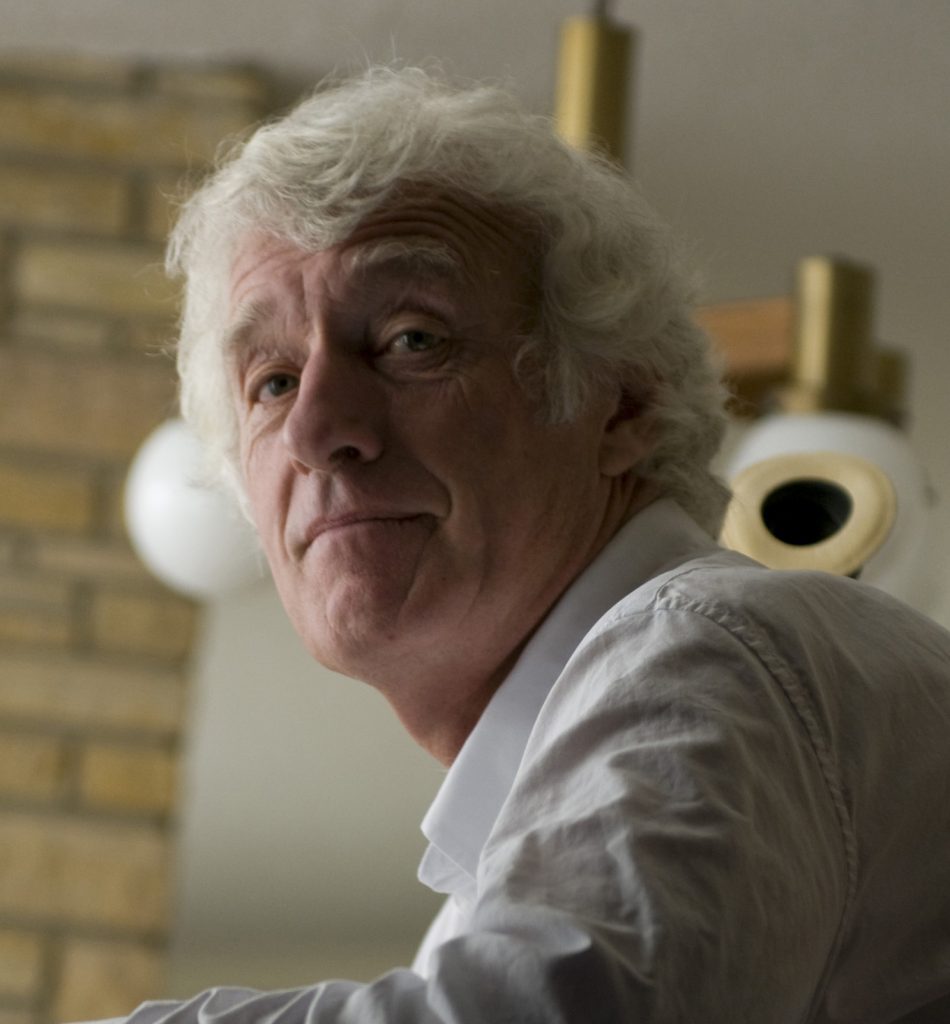
Roger Deakins. Courtesy of the artist.
There are 150-some photographs in the book, representing roughly five decades of work. How many pictures did you go through to come up with that selection? In other words, how big is your archive?
Not very big—I don’t really keep much, you see. I mean, I take a lot of photographs when I’m working on a movie, but they’re just a reference for the film. The photographs that I take for my own pleasure are quite few, really. I don’t have the time when I’m working, and thankfully I’ve had quite a productive career.
So you’re not somebody who carries a camera with you at all times?
I’m not that obsessed by it, I must say. I do have a camera with me most of the time when I’m shooting a film, but I think it’s a very different thing to spend your own time with a stills camera, looking for something that grabs you.
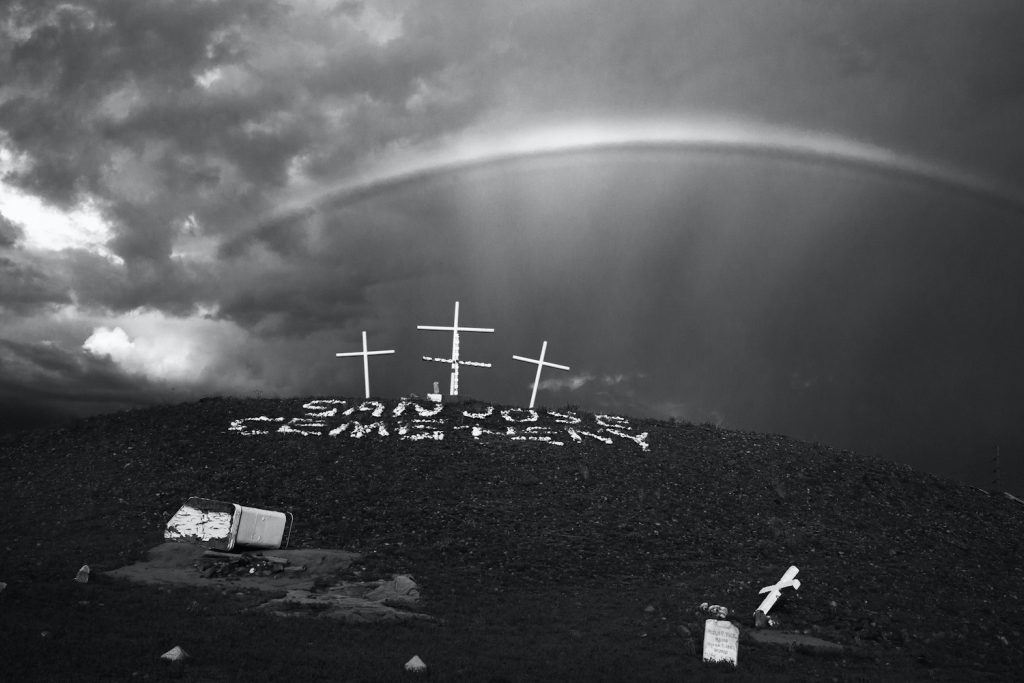
Roger Deakins, Albuquerque Cemetery Rainbow (2014). © Roger A. Deakins.
Do you use the camera to record memories, or is it more of an aesthetic instrument for you, a tool to make art?
I don’t like the word ‘art,’ really. [Laughs] I’ve obviously been on holiday and taken snapshots of a memory, but the photographs that are in the book, they just grabbed my attention. I liked the frame or I liked the light. Often I liked the slightly surreal quality of the image, a juxtaposition of things in the frame. It’s not art; I’m not a photographer and they’re not memory aids. I don’t sketch with a pencil. I sketch through the camera, I suppose.
In the foreword to the book, you write, ‘The choice of when to take a picture, and which of the resultant images has a future, reveals something of us as individuals. Each of us see differently.’ Do you think someone who knows your film work could see these images and know they were made by you? What are the ‘Deakins-isms’ we might see here?
I think there’s definitely a sensibility. That’s true even when I work on a film. I’m not the author of the film, obviously—I’m working for a director and with anywhere up to a couple of hundred people—but I do think you stamp your point of view, your taste, on the work you do. When I shoot films, you can see there’s a continuity, that there’s an individual behind the camera. I look at some other people’s work in film and that’s true, too. I could always recognize a film that was shot by Conrad Hall, for instance; there’s a certain sensibility that he had. That’s the case for still photographers as well.
Looking back through these photos, I wondered if my eye had changed, and I don’t think it has, really. The photographs I took back then are really quite simple; they’re pared down in terms of what’s in the frame. I guess that’s what I’ve been doing ever since. [Laughs]
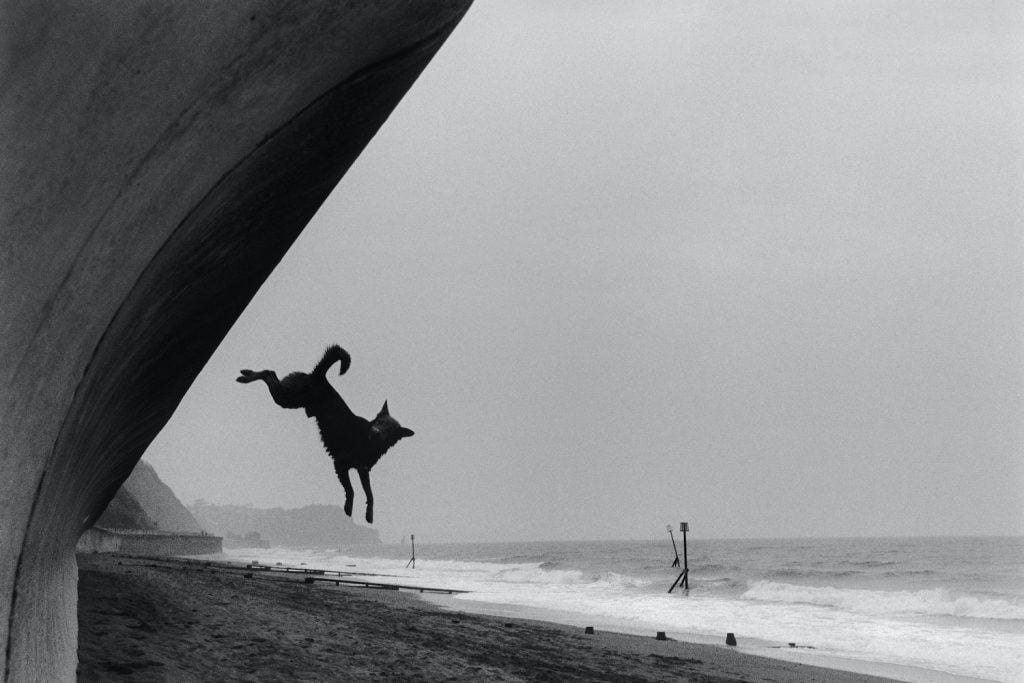
Roger Deakins, Teignmouth Dog Jumping (2000). © Roger A. Deakins.
Why haven’t you shared these pictures before now?
I don’t know, really. The earliest photographs I took in North Devon, and they’re part of a public archive. But the other images are just things I’ve shot over the years. Some of them were taken in Berlin, for instance. When we were over there working on a movie, I’d go out and explore the city on the weekend. I had my camera and would snap the odd shot. There’s probably three or four in the book from Berlin; maybe I only ever took a dozen total. I don’t take many photographs. It has to be something that grabs me, and then obviously you have to be able to get it at that moment. There are a lot of things that grab your attention but you miss the shot.
These are just photographs from here, there, and everywhere. There’s not really any structure to the book. There’s no rhyme or reason to it, other than the fact that they’re all shots that I like. Some people had asked, ‘Well, why don’t you do a book?’ And eventually I just thought, ‘Yeah, why not?’
One of the first jobs you had out of art school was as a photographer. Can you take me back to that gig? How did it impact the way you saw the world?
Originally I wanted to be a painter, a bohemian! [Laughs] Then, while I was at art college, I discovered photography. My paintings were fairly naturalistic, just based on things that I’d seen, so it made sense to have a camera and photograph the things I saw. A great photographer, Roger Mayne, was teaching at the school; he would come in for a few days every now and again. He was quite an inspiration, him and his work. So I thought I would become a photographer. But then I was talking to a friend who was applying to the National Film School, which was just opening the year that we were finishing at art college. I had always been interested in film, especially documentary filmmaking, and so it seemed like that might be a great opportunity.
Well, I didn’t get in the first time I applied. But in the interim, I was offered this job recording country life in North Devon. I was really hired as a recorder, not necessarily a photographer. I didn’t do a very good job, I don’t think, because I’m not very skilled at recording. I took a lot of photographs, but they weren’t great in terms of documenting a historical moment. Nevertheless, it was a great learning experience for me. I just spent all day every day with my camera, experimenting with framing and other things. It was a great time to play.
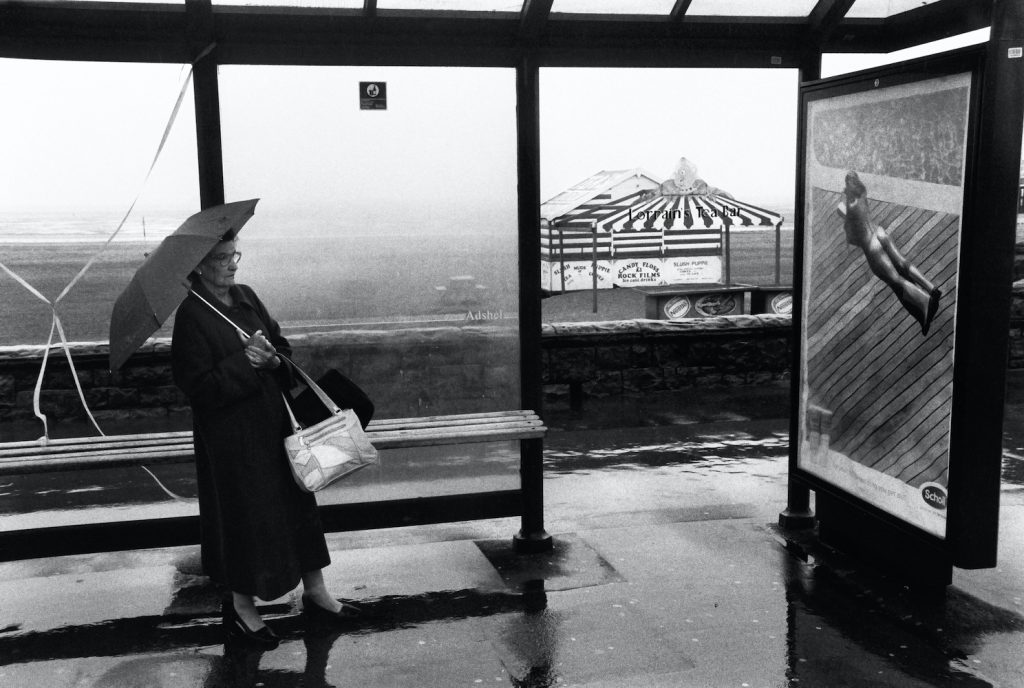
Roger Deakins, Weston-Super-Mare, Looking for Summer (2004). © Roger A. Deakins.
I was going to ask you about your relationship to painting. I know that you’ve always had a love of the medium. Does it influence your work behind the lens?
It’s funny, when somebody asks, ‘What are your influences?’ I don’t know what to say. Surely your influences are every experience you’ve had. There’s so many painters whose work I love and know quite well, whether it’s Francis Bacon or Edvard Munch or Giorgio de Chirico. I studied many of them in college. But to say how much they’ve influenced me, that’s hard. There’s a couple of photographs in the book that remind me of de Chirico, maybe, but is it an influence or just a coincidence? I’m just as influenced by growing up in South Devon and spending my childhood out at sea, fishing. These things accumulate.
All of the photos in the book are black and white, which might come as a mild surprise to people familiar with your work in film, where you have displayed such a mastery of color. What is it about black and white that interests you when it comes to still photography?
I’ve been trying to work in color and I just can’t do it. I just find it uninteresting! [Laughs] Black and white is much more about the content, the frame, and the light. Color can be so distracting. There are very few photographers that really work in color and use it well. Alex Webb is a great example of someone who can use color to his advantage.
Maybe it’s just because I grew up in love with the work of Brassaï and Bill Brandt and Alfred Stieglitz, all these great photographers that worked in black and white. Maybe I’m a bit of a dinosaur.
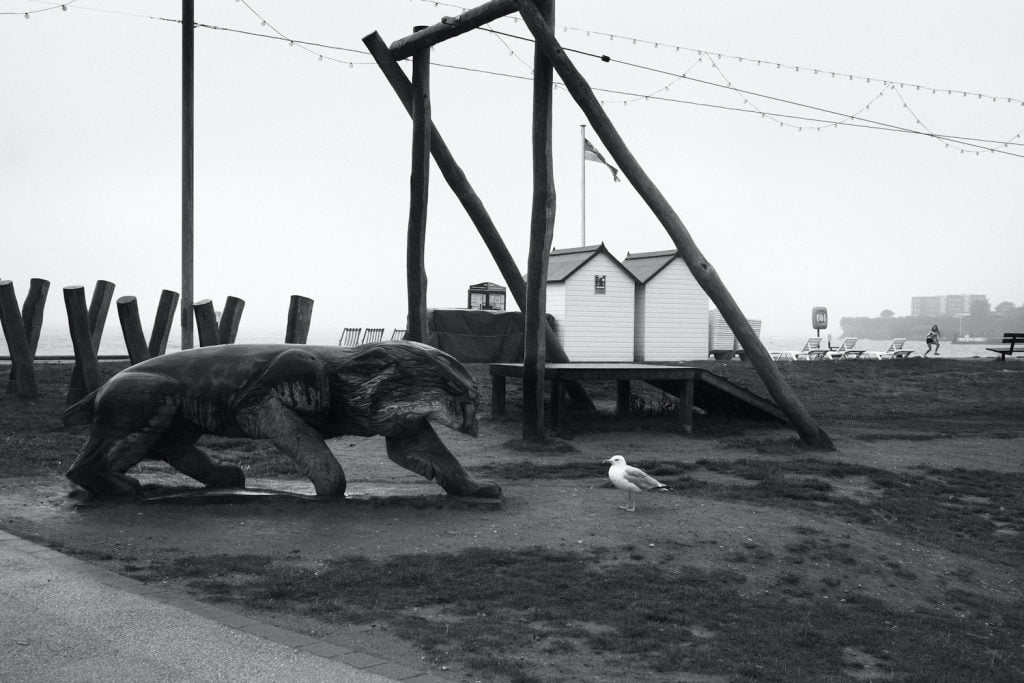
Roger Deakins, Paignton Lion and the Gull (2015). © Roger A. Deakins.
The relationship between film and photography is something I think about often. It’s a question I’ve asked many photographers in interviews like this one: ‘How has film informed your pictures?’ Every time, without fail, they play it down.
I believe it.
Why do you think that is? Do you feel that there’s a line to be drawn between the work you do as a cinematographer and your experiences taking photographs?
Obviously, there are things that you learn in one that help you in the other, technically speaking. But I do think capturing a still photograph is very different.
I say at the beginning of the book that I’m not a photographer, and I’m really not; I’ve just taken some pictures. But I think with great photographers, you look at their photographs and there’s a story within them. You can’t really do that in a movie because those frames keep moving. You can’t make the frames too complex, because you’re telling the story as a composite. It’s a different way of communicating, you know?
